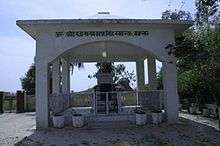Ram Baksh Singh
| Ram Baksh Singh | |
|---|---|
| Raja Rao of Daundia Khera | |
 | |
| Died |
28 December 1857 Baksar |
| Religion | Hinduism |
| Sisodia Rajputs of Mewar II (1326–1884) | |
|---|---|
| Hammir Singh | (1326–1364) |
| Kshetra Singh | (1364–1382) |
| Lakha Singh | (1382–1421) |
| Mokal Singh | (1421–1433) |
| Rana Kumbha | (1433–1468) |
| Udai Singh I | (1468–1473) |
| Rana Raimal | (1473–1508) |
| Rana Sanga | (1508–1527) |
| Ratan Singh II | (1528–1531) |
| Vikramaditya Singh | (1531–1536) |
| Vanvir Singh | (1536–1540) |
| Udai Singh II | (1540–1572) |
| Pratap Singh I | (1572–1597) |
| Amar Singh I | (1597–1620) |
| Karan Singh II | (1620–1628) |
| Jagat Singh I | (1628–1652) |
| Raj Singh I | (1652–1680) |
| Jai Singh | (1680–1698) |
| Amar Singh II | (1698–1710) |
| Sangram Singh II | (1710–1734) |
| Jagat Singh II | (1734–1751) |
| Pratap Singh II | (1751–1754) |
| Raj Singh II | (1754–1762) |
| Ari Singh II | (1762–1772) |
| Hamir Singh II | (1772–1778) |
| Bhim Singh | (1778–1828) |
| Jawan Singh | (1828–1838) |
| Sardar Singh | (1828–1842) |
| Swarup Singh | (1842–1861) |
| Shambhu Singh | (1861–1874) |
| Sajjan Singh | (1874–1884) |
| Fateh Singh | (1884–1930) |
| Bhupal Singh | (1930—1955) |
Raja Rao Ram Baksh Singh was a Hindu Rajput who was the Raja Rao[1] of Daundia Khera in Unnao district, in the then Oudh province that was a vassal state of the British East India Company.[2][3][4] He was one of the leaders of the Sepoy Mutiny, and a close associate of Nana Sahib. He was hanged by the British on 28 December 1857 for taking part in the revolt and being found guilty of the killing of British soldiers. In 1992, the Government of India built a memorial at the place where he was hanged to honor his death.
The dilapidated remains of his fort - consisting of the ruins of his royal mansion, a huge campus spread over hundreds of acres, a temple to Shiva which has been in use for more than 180 years, and various other structures - have been in the news recently due to an excavation for gold by the Archaeological Survey of India.[5][6] [7][8][9] The Archaeological Survey of India, upon excavation his fort in October 2013, discovered a brick wall, sherds, pieces of bangles, hopscotch toys, and a mud floor which could date back to the 17-19th centuries, but no gold treasure or any other valuable materials.[10]
References
- ↑ Rajput
- ↑ Civil rebellion in the Indian mutinies, 1857-1859 by Sashi Bhusan Chaudhuri, World Press, 1957, pp:102,104,107,127,143.
- ↑ Kaye's and Malleson's History of the Indian Mutiny of 1857-8 By John Kaye, George Bruce Malleson - 2010,pp:386
- ↑ Theories of the Indian Mutiny (1857-59): A Study of the Views of an Eminent Historian on the Subject by Sashi Bhusan Chaudhuri, 1965:pp 94.
- ↑ "The mystery of India's other golden temple: Archaeologists begin hunt for fabled hoard of treasure". The Independent, United Kingdom. 17 October 2013. Retrieved 26 October 2013.
- ↑ "Unnao gold hunt: ASI starts digging for prophesied 1,000 tonnes". India Today. 18 October 2013. Retrieved 26 October 2013.
- ↑ "Treasure hunt futile: Unnao king's relative". Times of India. 23 October 2013. Retrieved 26 October 2013.
- ↑ "Gold treasure hunt: Know who Raja Rao Ram Baksh Singh was". India TV. 19 October 2013. Retrieved 26 October 2013.
- ↑ "Archaeological Survey of India springs into action after sant dreams of treasure". DNA India. 19 October 2013. Retrieved 26 October 2013.
- ↑ "Unnao treasure hunt yield so far: shards, bangles, brick wall". Hindustan Times. 21 October 2013. Retrieved 21 October 2013.
`